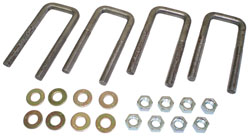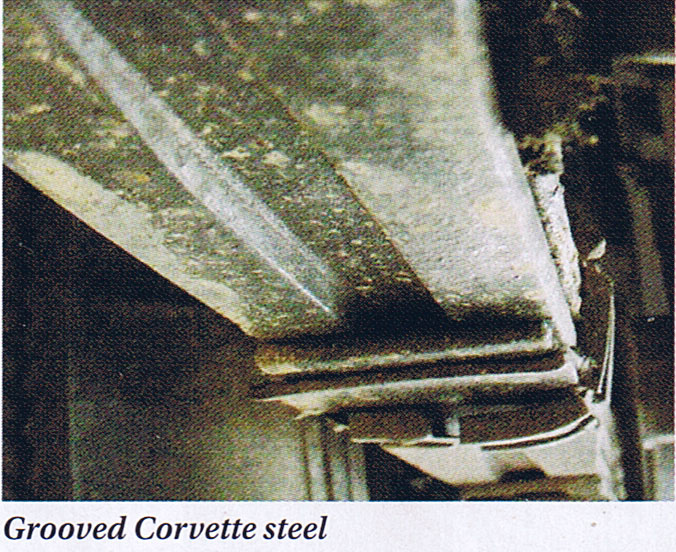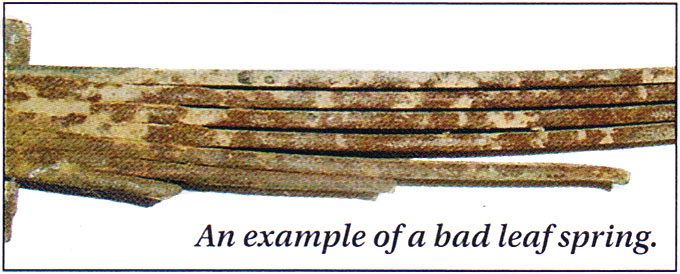Q: Can I weld to my springs?
A: This question does come up from time to time for various reasons. You should never weld on any spring. Welding on a spring or even weld splatter onto a spring will cause a stress riser which will cause the spring to break. Suspensions must be treated as a safety item. The failure of a suspension or suspension part can result in catastrophic damage.
If welding needs to be performed in an area of your vehicle near a spring, you must either remove the spring from the vehicle before welding, or take proper precautions that the spring does not come in contact with either the heat generated from welding, or any weld splatter.
Q: Should I grease my leaf springs?
A: Prior to mid-1950s, grease was put between the spring leaves. In fact, springs of many pre-1950 cars were wrapped in metal liners to hold the grease in. Some cars had hollow center bolts with grease fitting, so the springs could be lubed on the car.
The idea behind lubing between the leaves was to reduce inter-leaf friction. Then in the early ‘50s, the type of steel used to manufacture springs was changed to SAE 5160 and the practice of lubricating between the leaves stopped. Grease has an adverse effect on SAE 5160 steel. The chemicals in the grease react with the steel and cause the steel to breakdown. Take a look at the front springs on the next large truck you see leaning. There’s a good chance the power steering unit will be leaking onto the low side spring.
Q: Are mono-leaf springs safe?
A: Before we can answer whether mono-leaf springs are safe, let’s look at the makeup of both mono-leaf springs and the multi-leaf springs they attempt to replace.
A multi-leaf spring is not just a bunch of pieces of steel put together. It is an engineered system designed to provide support, stability and safety to a vehicle. In a multi-leaf spring, the length and makeup of each leaf is important because each leaf is designed to carry a proportionate amount of load and stress.
Also, each leaf is designed to provide support to the leaf above and below it. In the event of failure—and all springs eventually break—this feature will provide support for the vehicle. Mono-leaf springs consist of one plate of spring steel that is thick in the center and tapers out to the ends. The amount and length of the taper is critical to the durability and safety of the spring.
Remember, all springs have a finite life, meaning that, on day they will break.
When designing a leaf spring this eventual breaking must be taken into account. What will happen to the spring and the vehicle should this failure happen when a vehicle is in motion? A correctly designed multi-leaf spring is designed so each leaf carries a proportional amount of load, is stressed equally and will provide support to the vehicle when it fails.
The main leaf of the spring attaches the axle to the vehicle. A multi-leaf spring consists of a main plate and several supporting leaves. A mono-leaf spring is just a fancy main plate without the supporting leaves.
Q: What happens if the main leaf breaks?
A: Should the main leaf break, dire things could happen. When the main plate of a multi-leaf spring breaks in front of the axle, the axle may shift rearward. When the main plate of a multi-leaf spring breaks behind the axle, most multi-leaf springs will provide enough support to keep the body of the vehicle from dropping down onto the tires. When a mono-leaf spring breaks behind the axle, the body of the vehicle will drop down onto the tires and probably bring the car to a quick stop.
Q: What about the axle shifting rearward?
A: This might be a concern. Shifting of the axle causes a change in the control of the vehicle. This change of control can vary from slight to a complete loss of control.
In the case of a multi-leaf spring, it is extremely rare that the axle moves enough to cause a loss of control of the vehicle. However, in the case of mono-leaf springs, there is nothing to stop the axle from moving backwards.
The number of leaves, their stepping, the placement of the rebound clips, whether or not a wrap leaf is used and the type of axle attachment are all items that should be considered when designing a spring. A correctly designed multi-leaf spring will provide support to the main plate upon failure. With the correct placement and style of rebound clips, a main plate can be broken without any, or very little, shifting of the axle. In most cases, a vehicle with a broken multi-leaf spring can be safely driven to the repair shop.
Q: What is the best way to finish leaf springs: powder coating, painting or chroming?
A: Simply put, powder coating is a process where dry paint particles are sprayed onto the surfaces on the spring. Then the springs are heated, which melts and bonds the paint particles to the metal. In order to get the paint particles hot enough to bond they must be heated very close to the annealing temperature of the spring steel. Annealing means the heat treatment of the springs is being removed. Annealed springs will no longer support any weight. It will cost about $225 to $250 per spring to fix this mistake.
To have the powder coat work without softening the springs the heat must be held to less than 350 degrees.
Painting should not have to be explained. Use high-quality, high temperature engine enamel. Hang the spring by an eye and spray three to four coats of paint. Be sure to let the paint completely dry in between coats.
Whether powder coating or painting, do not cover the top of the leaves or the bottom part that is covered by the leaf below it. Either type of coating builds up a few thousands of an inch per leaf. With several leaves in a spring pack, the added thickness will be several thousands of an inch.
The weakest part of a spring is where the center bolt goes through the leaves. This section of a spring must be held with such a force that there is very little movement in the center bolt area.
As a spring flexes up and down, there is wear taking place between the leaves. If the inner surfaces have been coated this coating will wear through, allowing additional movement in the center bolt area. The additional movement will allow the U-bolts to loosen and soon you will experience either a sheared center bolt or a broken spring. There is no warranty on any spring broken between the U-bolts.
If the vehicle is driven, after three to four years rust will begin seeping between the leaves of a powder coated spring. A painted spring on a vehicle that is driven will also have rust begin to seep between the leaves after three to four years.
Q: What about chrome:
A: While a chromed spring looks neat, it can be a hidden time bomb. An improperly chromed spring may suffer from hydrogen embrittlement. This causes a spring to shatter, not break, into several small pieces.

A multi-leaf spring that simply breaks normally will still provide enough support to safely get the vehicle off the road. However a spring that shatters may not provide any support, leading to catastrophic results.
Chroming a spring is a very skilled procedure and should only be done by a chrome shop that is experienced with chroming springs.
Q: Can I cut my coil springs?
A: In a lot of cases it is fine to cut the coils. There are also cases where it cannot be done. If your springs have what is called “pigtail” ends, (where the ends have a smaller diameter then the body of the springs), then it cannot be done. If you try to stand the spring on its end and it stays upright, the ends are “square” and they cannot be cut.
The only types of coil springs that can be safely cut are those with “tangential” ends. Tangential ends look as though they just twist off into space. The spring would fall over if you tried to stand the spring up.
Q: What is the right way to cut a spring?
A: First, cut the coil with a hacksaw or a rubber cutoff wheel. (Be sure to use safety glasses.) Never use heat to cut a spring. The heat from a torch will change the structure of the steel. You will either end up with completely useless springs, or springs with a greatly shortened life. Don’t cut off the whole amount you need to lower your ride. Cut off about ¾ of the amount you wish to drop your ride. Then re-install the springs and test-drive the car at full force, do not baby it. You want the spring to find its seat and to fully flex.
Then recheck the ride height. If you are lucky you’ll be at the right height. If not, take the springs out and cut off a bit more. For front springs, it better to use a spring compressor. Remember, there is no way to making them longer, so be careful.
Q: Will my leaf springs settle?
A: All springs settle over time, however I believe the question should be, “How much will springs settle shortly after being installed?”
The answer is very little, providing the springs are the right springs for the vehicle. Springs support weight and this is why it is so important to be honest about the changes made to the vehicle. For every change made there can be a change in the amount of weight the springs will be required to carry.
Correctly manufactured springs, both leaf and coil are shot-peened, which removes stresses in the metal which occurs during the heat-treating process. The life of the spring is not only increased because of shot-peening, but the spring will not continue take “a set” once it is installed.
So how much settling is “very little?” Correctly matched springs will settle no more than ¼ to ½ in. once the car is finished and driven. Andy more than that means something is not right. Leaf springs will not settle any more than coil springs, nor will coil springs settle any more than leaf springs.
Q: I just broke a center bolt. What happened?
A: There is only one cause of broken center bolts, and that is loose U-bolts. The center bolt is necessary to hold all the leaves together and to locate the axle in correct position. The axle is located by the center bolt head that fits into a hole in the spring seat. Then the U-bolts are used to bind the spring and axle into one unit.
The U-bolts must be tightened to the proper torque specs to eliminate any movement between the spring and the axle and between each leaf of the spring. Should the U-bolts be loose, two things can happen—broken center bolts and broken leaves. When installing new springs be sure to use new U-bolts. Attempting to re-use the old U-bolts is being penny wise and pound-foolish.

Q: How do I correctly measure my leaf springs?
A: The correct way to measure the length of a leaf spring is to do so as though the spring is flat. The wrong way to measure is eye-to-eye. While measuring eye-to-eye may be the easiest, it is not accurate. The measurement you get is only good as long as the spring stays at that arch. As a spring flexes up and down, the distance between the eyes change.
A 48” (measured the correct way) with a 6” arch will measure 46 ¾” eye-to-eye. The same spring with a 3” arch will have an eye-to-eye measurement of 47 ¾”.
Also, the location of the center bolt is very important. Measuring eye-to-eye will not tell where the center bolt is located and the chances of your axle being in the right spot are not good. The only way to measure the length of a spring is to do it as though the spring was flat. Measure by following the curve of the spring, starting at the center of the front eye back to the center bolt. Then measure from the center of the other eye back to the center bolt.
These measurements are called the “divisional length” and are indicated as two different lengths. The 48” spring from above could have several “divisional lengths”: 24×24, 21×27, etc.
Spring arch is measured by splitting the center of the spring’s eyes with a straight edge. Then measure down from this line to the top of the main plate next to the center bolt. (The main plate is the leaf with the eyes). This measurement can be positive or negative. It does not matter which way a spring is bent, as it will work both ways. Setting the spring upside down and measuring from the floor to the main plate or to the bottom of the spring is incorrect because the steel thickness, eye sizes and eye shapes can vary.
“Free arch” is the term used for the arch when the spring is unloaded (off the vehicle).
“Loaded arch” is when the spring is under load (on the vehicle with weight on the springs).
To make it easy, Eaton Detroit Spring has created the Leaf Spring Measuring Form. It can be downloaded at www.eatonsprings.com/measure.
Q: Do I want my springs re-arched, or do I need new ones?
A: Re-arching is a term which applies to steel leaf springs only. Once fiberglass or composite springs lose their ability to support weight, nothing can be done to salvage them. Also, nothing can be done to salvage tired coil springs.
The re-arching process results in the spring being brought back to its original free arch. There are two ways of re-arching a spring, but only one correct way. The only acceptable method of re-arching starts by erasing the spring’s memory by annealing the steel, then reshaping and finally reheat-treating each leaf in the spring.
In order to anneal a spring it must first be taken apart. Then each leaf is visually inspected for signs of fatigue. Then each leaf is shot-blasted to remove all paint, rust, etc. and re-inspected.
If the leaves are in good condition, then each leaf is heated to at least 1,650 degrees Fahrenheit. Once heated, the leaf is placed on a pattern that has the correct shape and arch. The leaf is quenched in special oil to quickly cool it. The heating and quick cooling process results in a leaf that is too hard or brittle to be a spring. The leaf is then re-heated to at least 950 degrees for a set amount of time drawing out some of the hardness. Once cooled, the leaves are then shot-peened to relieve stress and reassembled. The final product is a properly tempered, re-arched and heat-treated spring. The most popular method is to use either a hammer or a press to change the arch. This is known as “cold setting.” Using the “cold setting” method will result in a short-term fix and is not an acceptable way to re-arch a spring.
Q: What needs to be considered before having a spring re-arched?
A: There are some considerations to be made prior to having springs re-arched, the first being cost. Re-arching is at a premium above the price of new springs. Then you must add to this the price of new bushings, liners, clips, labor to reassemble them and shipping costs. The old parts cannot be reused. However, if you have a straight axle Corvette or any other car with original style grooved steel; the cost is well worth it to maintain originality because this type of steel is no longer made.

The second consideration is the condition of the springs. Are any leaves broken?
Are the leaves separating towards the ends?

Are there pit marks on the flat sides of the leaves? (The pit marks can look like small rust spots). Are there lines like those on the palm of your hand running across the flat sides of the leaves?
If your springs show any of these conditions, they would not be candidates for re-arching.
